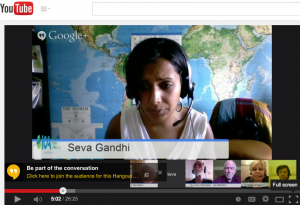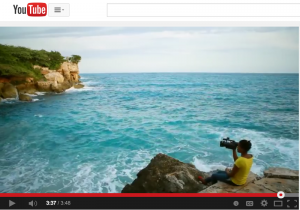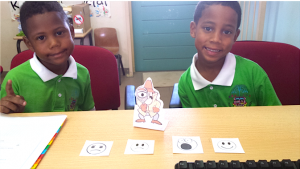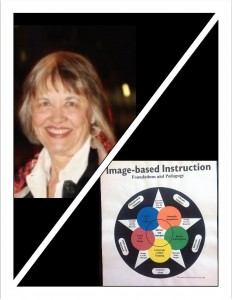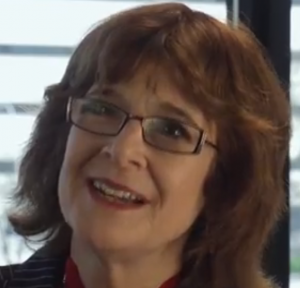Watch Seva Gandhi and James Addington describe a collaborative learning project that involved classes from 7 universities more than 200 interns in 77 Chicago neighborhoods for a city wide “Share Fair”. Their work is an interesting example of project based learning. Collaborative Learning Project
Category Archives: Uncategorized
She says in Haiti: ” I am moving closer to my dream”
A girl in Haiti making images…”I am moving closer to my dream”
what master class shall we teach now, do you think?
A Quote about the Pedagogy of Knowing
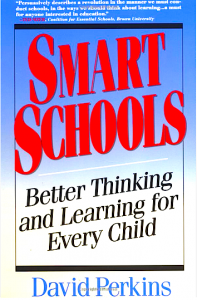 From Jo Nelson A quote from David Perkins in his 1992 book “Smart Schools” (as quoted in Art of Focused Conversation for Schools) — “There is an important connection between a pedagogy of understanding and this notion of mental images ……What do people have in their heads when they understand something? Contemporary cognitive science has a favourite answer: mental images (many psychologists would say “mental models” to mean the same thing). Roughly defined, a mental image is a holistic, highly integrated kind of knowledge. It is any unified, overarching mental representation that helps us work with a topic or subject….. Mental images…concern very basic things such as the layout of your home or the shape of a story. But mental images can also concern very abstract and sophisticated matters.”
From Jo Nelson A quote from David Perkins in his 1992 book “Smart Schools” (as quoted in Art of Focused Conversation for Schools) — “There is an important connection between a pedagogy of understanding and this notion of mental images ……What do people have in their heads when they understand something? Contemporary cognitive science has a favourite answer: mental images (many psychologists would say “mental models” to mean the same thing). Roughly defined, a mental image is a holistic, highly integrated kind of knowledge. It is any unified, overarching mental representation that helps us work with a topic or subject….. Mental images…concern very basic things such as the layout of your home or the shape of a story. But mental images can also concern very abstract and sophisticated matters.”
Jeanette Stanfield’s “Courage to Lead” Workshop in Toronto
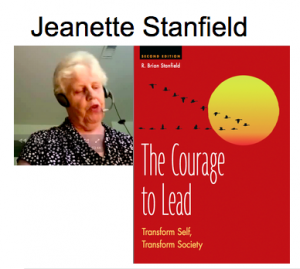
Q: How do you teach 20 Somethings to take a stand in their life and work, lean forward and lead?
Jeanette has designed a workshop with four great questions that gets people started on an inquiry.
If you want to hear her read from Brian’s book and explore her work please add a comment
Jeanette Stanfield’s Courage to Lead Workshop
MR ORID at the University of Aruba from Jan Sanders
Francois wanted to take away the toy that Mathias was playing with, but Mathias would not let the toy go. Francois got mad and kicked Mathias in his belly. Mathias got scared, cried from the pain and told the teacher on Francois.
When students are sent to the principal because of their misbehavior, Mr. ORID takes charge of the conversation and guides the students (ORID facilitation method) to reflect and solve their social-emotional difficulties.
At the end Francois learned that he has to wait for his turn or ask if he can play with the toy instead of the way he reacted. Mathias learned that he has to say ‘No’ and not to stay quiet but was praised for notifying the teacher.
The Principle, Mr. Gino Vrolijk is learning imaginal education practices in the post-secondary certificate program called Education Leadership for Collaboration offered by the University of Aruba and taught by Jan Sanders, Robertson Work, Skye Burn and Doug Banner.
Loren Weybright coaching along side the teacher at Glen Buds School in Nepal
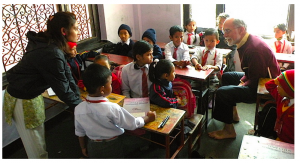 At the Glen Buds school in Nepal, Loren works, as a coach, alongside Pratima, the Nepali teacher, and her second graders, discussing new strategies for teaching.
At the Glen Buds school in Nepal, Loren works, as a coach, alongside Pratima, the Nepali teacher, and her second graders, discussing new strategies for teaching.
Earlier, Pratima had made a commitment: “I want the children to talk more with each.” Today we were discussing ways she could use real objects, and have small groups or partners label them in Nepali and English.
Here is a link showing more detail about teaching, mentoring & education at Glen Buds School
Central Questions for Educators:
What is the role of a coach (or mentor) in your own setting, in supporting teachers, first to set their commitments for change, then to follow through with those changes?
How do you help teachers and caregivers make changes in their practice that:
- Engages children
- Creates knowledge and new actions/behaviors
- Becomes a lasting part of the practice
- Applies to new situations
What’s it like to practice Imaginal Education in the Classroom?
Q OliveAnn Slotta: What is the current practice of Imaginal Education in the classroom?
Oliveann Slotta: I edited a book on Imaginal Education to try to answer that exact question: Image-based Instruction – Foundations and Pedagogy was designed so that anyone, [even someone not specifically trained in Imaginal Education could teach using one or more of the methods.
The book is really a workbook or manual – it has all the charts, handouts, lecture notes that anyone would need to get started using basic immaginal education tools.
-
Chapter 1 describes and analyzes Kenneth Boulding’s “theory of knowledge” and applies it to address individual students’ mental models toward improved motivation and attention. Specifically, Boulding theorizes on how a student’s images effect his or her behaviour and how changed images make a substantial difference (see The Image.)
Chapter 2 features the ICA’s “Conversation Method” of designing an intentional conversation flow with any group of students using a carefully crafted sequence of questions. An acronym for the question flow is conveniently referred to as “ORID” which stands for Objective, Reflective, Interpretive, and Decisional level questions.
Chapter 3, my personal favorite! It empowers my daily teaching, and is the ultimate Curriculum Design model. This is a wholistic system of designing curriculum using a three-part “symphony” image to plan curriculum for any period of time, whether an entire unit or a daily lesson. The product of this approach is a pallet of objectives—both measurable and experiential—as well as learning activities, which results in scripted notes to guide both classroom presentations and future planning. This chapter also shares the Kaleidoscope symbol, featuring fifteen different aspects of carefully planned curriculum that can be used by the teacher or professor to prompt her or his planning to be learner-centered and to ultimately “Reveal the Wonder” of learning.
Chapter 4 shares the image of a Community of Practice about how you might apply a collaborative method of teachers working together as learning facilitators.
Elsewhere in the blog are chapters that discuss current education themes, such as “Flipped Lessons“ where students are given the lecture on video as homework, then the teacher/professor spends more time answering follow-up questions, mentoring individual students and coaching small working groups doing “project-based inquiry”
Want to keep track of our progress? Click the “Subscribe” button.
Tim Dove Speaks of Imaginal Education
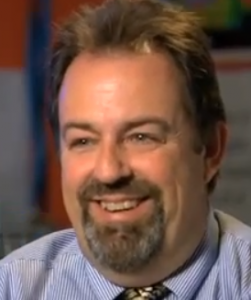 Tim Dove was named “Teacher of the Year” in Ohio last year. See how Tim credits Imaginal Education for the success of their fabulous results at the Phoenix Middle School in Worthington Ohio.
Tim Dove was named “Teacher of the Year” in Ohio last year. See how Tim credits Imaginal Education for the success of their fabulous results at the Phoenix Middle School in Worthington Ohio.
Training Futures and Imaginal Education
Training Futures is an award winning adult skills training program of Northern Virginia Family Services. Watch Susan describe how Imaginal Education makes the program successful.
Ronnie Seagran’s In Context magazine Imaginal Education Article
This is a very good comprehensive overview of Imaginal Education written in 1988.
http://www.context.org/iclib/ic18/seagren/
